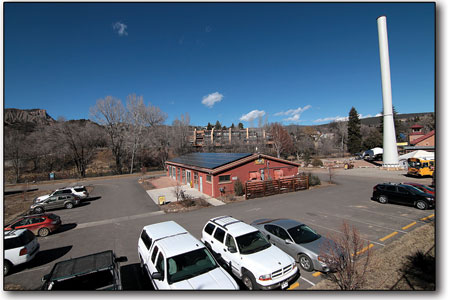 |
|
A view of the proposed STEAM Park site near the Powerhouse Science Center and Durango Fire’s downtown station along the Animas River. BNIM, a Kansas-City based firm, is set to reveal the results of a feasibility study Feb. 17 and 18, giving Durangoans an idea of what it would take to make the project a reality./Photo by Jennaye Derge
|
Full STEAM ahead
Firm presents feasibility study results to City Council, community
by Tracy Chamberlin
It all began with one building, a tightly packed and aging space known as the Durango Arts Center.
Carol Saloman, who serves on the center’s Advisory Board, approached fellow board member, Terry Bacon, about a year and half ago to discuss rebuilding the DAC.
The first question they asked: Where could a new arts center go?
Those conversations ultimately led to the idea of a cultural showcase for the arts and sciences along the Animas River called the STEAM Park, which stands for Science, Theatre, Education, Art and Music. The park would be home to galleries, a theater, classrooms, shops, office space and more.
“This could be an opportunity to create collaborative partnerships,” said Bacon, who now serves as the board president.
Local organizations who have already signed on to the project include the Durango Arts Center, Powerhouse Science Center, Durango Film, Music in the Mountains, San Juan Symphony and the Stillwater Foundation.
With a vision for the future in hand, the next step was to find out if it’s at all possible and what it would take to make it a reality.
JusttheFactsWhat: Steampark Feasibility Study presentation to City Council |
Those involved with the STEAM Park project, in conjunction with the City of Durango, turned to BNIM, a Kansas City-based firm with years of experience developing feasibility studies for theaters and cultural sites across the country.
Along with Development Initiatives, Highline Creative and local firm Goff Engineering, BNIM was hired last November to put together the STEAM Cultural Park Feasibility Study.
Their goal was to find out what it would take to transform the site into a cultural showcase, including funding needs for construction and operation, as well as identifying challenges, economic impacts and more. 4
Along with the firm’s director of planning, BNIM project manager Gunnar Hand, AICP, will present an overview of the study process, analysis, findings, recommendations and the next steps to the Durango City Council and the community.
City Council gets the first glance during an official presentation at 4 p.m. Tues., Feb. 17, at City Hall, 949 E. 2nd Ave. The following day, Hand will present the results at an open house for the community beginning at 11 a.m. Wed., Feb. 18, at the Durango Recreation Center.
The No. 1 question the study was meant to answer: Is it even possible to build the STEAM Park along the riverfront property?
The simple answer is yes. It is feasible, according to Hand. But the project is not without its challenges.
“What we found through the process was that there was general support for the idea, but a lot of different conditions for that support,” Hand said.
The conditions and challenges the project’s leaders are likely to face include the need for parking, access to the site and minimizing congestion along Camino del Rio, all while preserving the park-like nature of the project and finding alternative sources of funding.
Some of the challenges are well known to the STEAM Park Board members, like potential funding concerns and the fact that City Planning Department offices and Durango Fire and Rescue’s downtown station are currently located on the proposed site.
According to Sherri Dugdale, assistant to the City Manager, the city does not have any plans to assess where, how or when the planning offices could be moved, and the fire department leases the station and has its own separate planning process.
Exactly how much it would cost to build and operate the park is one of Bacon’s No. 1 questions. He wants to know if an estimated $30 million price tag that’s been floated is grossly overestimated or grossly underestimated.
 He said they want the operational costs to be sustainable. “We don’t want to be a burden on the town,” he added.
He said they want the operational costs to be sustainable. “We don’t want to be a burden on the town,” he added.
Bacon thinks the funds will likely come from a combination of private donors, corporations and foundations. And, he might not be far off.
During the study process, Hand said the firm discovered it will take significant private donations for both construction and operation of the STEAM Park. “It could require significant private dollars,” he added.
Another question Bacon is eager to see answered Wednesday: Are there issues or concerns with the proposed site that the committee has not considered?
“I will be there eager to hear their conclusions,” he said.
The price tag for the feasibility study is $150,000, funded by an Energy and Mineral Impact grant from the state worth $75,000, a match of $37,500 from the City of Durango and the balance coming from private donations.
The process included community outreach, which resulted in more than 900 responses, two public events and interviews with stakeholders.
Hand said it’s a good response rate for Durango’s size considering the turnaround time for the project, which was about three months. “I think we got a pretty good read,” he said.
Bacon agrees it’s a good guage of community response and will be a captive member of the audience.
In this week's issue...
- September 11, 2025
- Back on top
After harrowing flying accident, local highliner steps back out with renewed mission
- September 11, 2025
- New order
Rule change for Land and Water Conservation Fund raises alarms
- September 4, 2025
- Armed with knowledge
Local community organizers work to ensure immigrant neighbors know their rights
